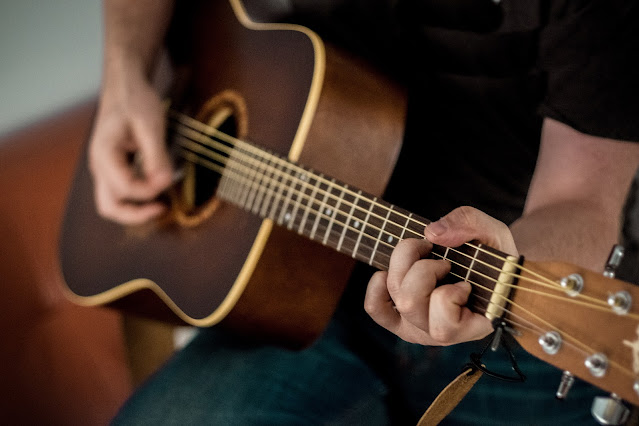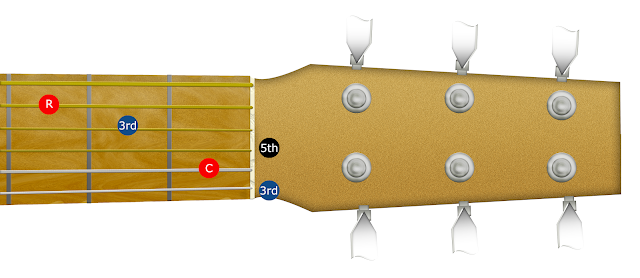We’re going to start looking at chord shapes in this lesson.
You'll learn how to:
- create and move the C shape
- play major chords with the C shape
- change major chords into minor chords with the C shape
I explained in a previous lesson, that you should assign a shape name to particular patterns, rather than chord names. So think of this as the C shape, rather than the C chord.
This is because a lot of guitarists get stuck on the idea that a specific shape is fixed to one particular chord. So for example, a lot of guitar players might see this shape, and think that’s how you play a C.
That’s correct, you can play a C this way, but you can also play a D, an E, an F, a G and so on, with this shape.
When we play the C shape in the first position on the fretboard, we get the C chord.
If we look at which individual notes are being played, we can see they they are all in the key of C.
C (our root note), E, G (open string), C, E (open string)
The G note, and the E note, are open. You don’t need to fret those notes in this position, because the nut of the guitar is doing that for you.
The notes that are fretted here, are the notes that spell out my chord - C is spelled C, E, G. So I know which notes my fingers are playing, because I know how to spell the C chord, I don’t need to try and memorise the fretboard, or rely on any other kind of mental maths for this.
Moving the C shape to create other chords
Now, if I want to move this shape down a whole step, so my root note is on the D note, I know that I am also playing a third interval, and a fifth interval note, because the shape remains the same, on the fretted notes.
So I will be playing a D, F#, A (you know the the previous lesson, how to spell the D chord, so you can be confident, if you are playing the 1, 3 and 5 interval notes you will be playing a D, an F#, and an A note.
If you barre with your first finger, on the second fret, you can play the A note on the G string and the F# note on the E string. This means you am playing all 1 notes, 3 notes and 5 notes.
Playing an E chord with the C shape
Now, let’s move another whole step up the fretboard and play this shape with the root note of E.
The fretted notes I’m playing now, the 1, 3 and 5 will be E, G#, B. And sure enough, that’s how we spell the E chord. Go back to the lesson on how to spell major chords if you need to revisit this.
1 E
2 F#
3 G#
4 A
5 B
6 C#
7 D#
The open note, E, is still in key, but now you need to play a G#, not a G on the third string.
Pretend that your index finger is the nut of the guitar, as you move the shape down towards the soundhole. All the notes will be in key - they’re all in the E major key.
You can move this whole shape up again to play an F, a G, and so on.
All chord shapes are moveable
So, you need to understand these full chord shapes to open up the range of chords that can be produced from them. This is not just a C chord, this is a C shape playing a C chord, and that C shape is moveable and can create any other major chord.
Understanding this will build up your chord library really quickly. It will free you to play in more than one area of the neck.
Just by being able to name the root notes on the fifth string, you can now play any major chord using the C shape.
C chords within the C shape
But that’s not all. Within this C shape, there are several ways to play each of the major chords.
Let’s stick with the C chord for now. All we have to do, is find a one note, a third interval note, and a fifth interval note and we have a chord. So within this shape we have:
- 1 chord we can play across five strings
- 1 chord we can play across the bass notes
- 1 chord we can play across the treble notes
So with this one shape, you can see how we can play tens of chords, up and down the fretboard.
Your tonic note, doesn’t have to be at the top of the shape, as long as you are playing it as part of your triad. This is called an inversion.
Because we’ve taken the time to know how to spell our chords, we can also identify which notes we’re playing, based on their position in relation to the root note - we know where our thirds are on the fretboard, and we know where our fifths are on the fretboard, in relation to that root note.
And this is just one shape!
Playing minor chords within the C shape
You’ll be pleased to know that we can easily double the amount of chords you’ve just learned.
You’ll remember that to change any major chord to a minor, we simply flatten the third interval note or notes.
Because you've invested the time in understanding where your one note, your third interval notes, and your fifth interval notes are in this chord shape, you can change all these major chords to minor chords by flattening the thirds.
Guitar practice journal
Download the Guitar Practice Tracker today. It will help to keep you motivated and give you a visual representation of your progress, and areas of focus throughout the year.
A guitar journal will enable you to:- Set personalised goals and monitor your progress
- Identify the number of hours or days you've spent on a particular skill
- Provide a quick reference to the notes and chords in a particuar key
- List the songs you know and sort by key, capo placement, artist, and chord progression
- Link directly to your favourite YouTube videos and tutorials
Download the Guitar Practice Tracker
Go to Lesson 9: The A shape guitar chord
If you enjoyed this lesson, and you're able to, please
Photo by 42 North


